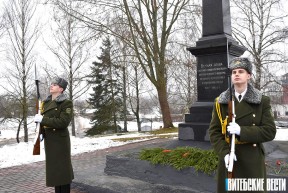Osveya was awarded the pennant “For courage and fortitude during the Great Patriotic War”

In the Osveisky and Drissensky (now Verkhnedvinsky) regions, partisan formations were active. The youth also stood up to fight the enemy. In the summer of 1942, an underground Komsomol youth organization was created in the village of Proshki. From August to November, its members distributed leaflets and Sovinformburo reports among the population, collected information about the enemy, weapons, and carried out sabotage. By the end of 1942, young people joined the partisans.
At this time, the 1st and 2nd Drissen brigades and the Osvey partisan brigade named after Frunze were already resisting the punitive forces. Together with the Kalinin partisan and Rosson brigades “For Soviet Belarus” and “I. V. Stalin" waged a joint struggle against the Nazis.
In June 1942, partisans of the detachment named after. Sergei (commander S. Kh. Koryakin), the Frunze detachment (commander I. K. Zakharov) and a group of Latvian partisans defeated the enemy garrison in the town of Shkaune on the territory of Latvia. And then they gave battle to the punitive forces pursuing them near the village of Lisno.
On August 4, 1942, partisans carried out an operation to blow up the railway bridge at the Benislavsky crossing (Drissensky district) on the Polotsk-Daugavpils railway section. The movement of enemy trains was stopped for 20 days. This was the largest operation in all of Belarus at that time.
As a result of the joint actions of Russian, Belarusian and Latvian partisans, by 1943 the Osveysko-Rosson partisan zone was formed, which occupied an area of about 10 thousand square kilometers. District party and Komsomol committees and local self-government bodies operated here. The newspapers “Vitebsk Worker” and Kalinin’s “Proletarskaya Pravda” regularly arrived here, and the operational group of the Central Committee of the Communist Party of Latvia published its printed publications. Desperate attempts by the Nazis to liquidate the partisan region ended in failure, although the Nazis organized one after another punitive expeditions against the partisans and civilians.
The official purpose of these operations was to fight the partisans; their result was the mass destruction of local residents. For most of their bloody operations, the Nazis selected sonorous poetic names: “Silver Fox”, “Harvest Festival”, “Warm Wind”, “The Magic Flute”, “May Thunderstorm”.
In February 1943, the most brutal punitive expedition was carried out, codenamed “Winter Magic”. These events are known in history as the Osvey tragedy.
The punitive expedition "Winter Magic" began on February 15, 1943 and lasted until the end of March. The Nazis planned to create a neutral zone 40 km wide in the Osveya – Drissa – Polotsk – Sebezh – Rossony region. This strip of land without inhabitants or settlements was supposed to deprive the partisans of their strongholds. The operation involved 5 SS regiments, 14 police battalions (including 7 Latvian ones), special units of the 3rd Tank Army, and the 2nd Special Purpose Air Group.
Over the course of a month, 158 settlements in the region (3,450 residential buildings), the regional center of Osveya and the town of Kokhanovichi were burned in the Osveya region.
Of the 21 thousand, only 6.5 thousand residents returned to the ashes. Thousands of people became prisoners of concentration camps.
Tragic events took place in the village of Rositsa: the Nazis killed 1,528 civilians from several surrounding villages, including Catholic priests Yuri Kashira and Anthony Leshchevich, canonized in 1999. More than 3 thousand people were drowned in the Svolno River.
However, no punitive expeditions could break the will of the partisans and underground fighters.
On February 26, 1943, at a meeting of the Central Headquarters of the Partisan Movement, the partisan detachments were subordinated to a single leadership under the command of the chief of the Kalinin headquarters of the partisan movement, Alexei Shtrakhov.
By his order, the partisan forces were divided into two groups - northern and southern. The first task was to stop the enemy on the Tserkovno - Mikulino line and bypass his positions in the Osveya - Velikoye Selo area, the second task was to contain the enemy in the Novoselye - Zadezhye direction.
The total number of Soviet partisans in the Rosson-Osvei partisan zone at the beginning of 1943 exceeded 8,000 people.
In March 1943, the people's avengers went on the offensive. Belarusian troops broke through the enemy's defenses. Peace came to the heroic land of the partisan region in the summer of 1944.
In the 60s of the 20th century, it was decided to perpetuate the memory of all the victims of the Osveya tragedy: hundreds of people brought earth from the sites of burned villages and mass graves to Osveya, which became the basis of the Mound of Immortality. An obelisk is installed on its top. In total, there are more than 300 monuments and obelisks on the Verkhnedvinsk land. A Memorial Memorial and Alley of Heroes have been created in the city center. The streets are named after the liberating soldiers. Fellow countrymen sacredly honor the memory of the feat of the generation of winners.


